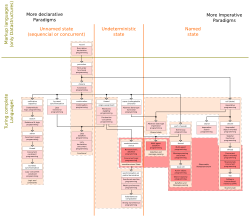this keyword
1 2 3 4 | |
Testing Existance
Using the loose inequality operator !=,
it is possible to destinguish between null, undefined
and anything else:
1 2 3 4 5 6 7 8 9 10 11 12 13 | |
Testing Truthy
1 2 3 | |
this keyword1 2 3 4 | |
Using the loose inequality operator !=,
it is possible to destinguish between null, undefined
and anything else:
1 2 3 4 5 6 7 8 9 10 11 12 13 | |
1 2 3 | |
In computer science, functional programming is a programming paradigm, a style of building the structure and elements of computer programs, that treats computation as the evaluation of mathematical functions and avoids state and mutable data. Functional programming emphasizes functions that produce results that depend only on their inputs and not on the program state—i.e. pure mathematical functions. It is a declarative programming paradigm, which means programming is done with expressions. In functional code, the output value of a function depends only on the arguments that are input to the function, so calling a function f twice with the same value for an argument x will produce the same result f(x) both times. Eliminating side effects, i.e. changes in state that do not depend on the function inputs, can make it much easier to understand and predict the behavior of a program, which is one of the key motivations for the development of functional programming.
1 2 3 4 5 6 7 8 9 10 11 12 13 14 15 16 17 18 19 20 21 22 23 24 | |

A programming paradigm is a fundamental style of computer programming, a way of building the structure and elements of computer programs. Capablities and styles of various programming languages are defined by their supported programming paradigms; some programming languages are designed to follow only one paradigm, while others support multiple paradigms.
In JavaScript we can find multiple paradigms.
That type of programming is based on describing actions.
It is about thinking about algorithm which solves the problem and implementation of it, nothing more.
That type of programming is based on prototypical objects.
That type of programming is based on manipulation of execution model.
List of most common Linux commands.